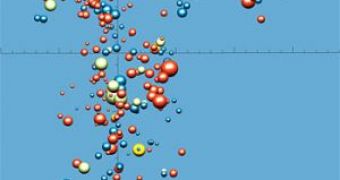For the first time, astronomers have mapped a mega-structure in the distant universe and showed the cosmic suburbs are full of action. Large galaxy clusters, considered to be the metropolises of the universe, are connected by space filaments that look like highways, to younger, more active galaxies, the cosmic suburbs of the universe.
Lori Lubin of the University of California, Davis, and Roy Gal of the University of Hawaii at Manoa, led the team of astronomers that focused their attention on what happens in the galactic suburbs, rather then the "big cities."
"The most interesting thing that we've found so far is the incredible amount of activity occurring in galactic suburbia," said Lubin, who is the principal investigator of the Observations of Redshift Evolution in Large Scale Environments (ORELSE) Survey. "We see unusually large numbers of galaxies with high star formation rates, producing over 100 new suns per year, and with active central supermassive black holes."
Among the first extensive surveys of large-scale environments around very massive galaxy clusters between 6 and 9 billion light-years away, ORELSE is used to provide scientists with new clues regarding physical properties that affect galaxies in the cluster outskirts and understand the interactions that leave them forever changed.
"Our research is like mapping the whole Big Island of Hawaii instead of just Hilo," said Gal. "We have already discovered the largest known supercluster -- a cluster of clusters -- present when the universe was half its current age."
The team used nine different earth-based telescopes to gather data about the cluster suburbs, like the 10-meter Keck I and II telescopes, the Very Large Array in New Mexico and the 5-meter Palomar telescope in California, and three space observatories of NASA's Great Observatories: the Spitzer and Hubble space telescopes and the Chandra X-ray Observatory.
Our own galaxy, the Milky Way, is currently sitting in a galactic suburbia, with the nearest cosmic metropolis being the Virgo Cluster of galaxies, located approximately 100 million light-years away.

 14 DAY TRIAL //
14 DAY TRIAL //